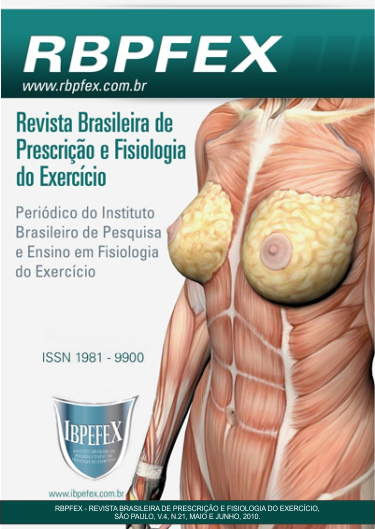Effects of aerobic continuous training and interval training on blood lipid profile in over fat women
Abstract
Objectives: Analyzethe effects of the interval and continuous aerobic training on plasma lipids of women with body fat excess. Materials and methods: The sample was made by 8 women with perceptualof body fat above 24% and divide in 2 groups, group 1 (n=4; age 22.11±1.45) that realized a continuous training at 60% of HRmax, group 2 (n=4; age: 23.53±1.51) that realized a interval training interchanging 2 min of effort at 90% of HRmax and 2 min of recovering at 60% of HRmax. Both groups realized 45 min exercises sessions, 3 times a week, during 8 weeks and were submitted to an anthropometric evaluation and blood collect pre and after training. Results: In none of the evaluated variables (weight, CT, HDL, LDL, VLDL and TG) were found significant statistics differences (p<0.05) pre and after training, such as in the continuous group training as in the interval training, and between both groups. Discussion: Several studies show that the volume factor has been demonstrating great relationship with alterations in the plasma lipid profile. Conclusion: The continuous or interval training, realized for 45 min, 3 times a week, in an 8 weeks period, don’t produce significant alterations in the level of plasma lipids in women with excess of body fat.
References
-American College of Sports Medicine. Position stand on the recommended quantity and quality of exercise for developing and maintaining cardiorespiratory and muscular fitness, and flexibility in healthy adults. Medicine Science of Sports and Exercises, 1998.
-Assman, G. Coronary Heart Disease: Reducing the Risk: The scientific background to primary and secundary prevention of coronary heart disease. A world wide view. Arteriosclerosis, Thrombosis, and Vascular Biology. Vol. 8. 1999. P. 1819-24.
-Brooks, S. Program design for personal trainers. IDEA Personal Trainer, 2000.
-Curi, R.; Pompéia, C. Entendendo a gordura: os ácidos graxos. São Paulo. Manole. 2002.
-Damaso, A. Nutrição e exercício na prevenção de doenças. Rio de Janeiro. Medsi. 2001.
-Dantas, E.H.M. A prática da preparação física. 5° edição. Rio de Janeiro. Shape. 2003.
-Guedes, D.P.; Guedes, J.E.R.P. Distribuição de gordura corporal, pressão arterial e concentrações de lipídios-lipoproteínas plasmáticas. Arquivo Brasileiro de Cardiologia. Vol. 70. Num. 2. 1998. p. 93-98.
-Krauss, R.M. Lipids and lipoproteins in patients whit type 2 diabetes. Diabetes Care. Vol. 27. Num. 6. 2004. p. 1496-1504.
-Kraus, W. E.; e colaboradores. Effects of the amount and intensity of exercise on plasma lipoproteins. New England Journal of Medicine. Vol. 347. Num.19. 2002. p. 1483-1492.
-King, C.A.; Haskell, W.L.; e colaboradores. Long-term effects of varying intensities and formats of physical activity on participation rates, fitness and lipoproteins in men and women aged 50 to 65 years. Circulation. Vol. 91. 1995. p. 2596 –2604.
-Leon, A.S.; Sanchez, O.A. Response of blood lipids to exercise training alone orcombined with dietary intervention. Medicine Science Sports and Exercises. Vol. 33. Num. 6. 2001. p. 502 –515.
-Londeree, B.R.; e colaboradores. %VO2máx versus %HRmáx regressions for six modes of exercise. Medicine Science of Sports and Exercises. Vol. 27. Num. 3. 1995. p. 458-461.
-Mcardle, W. D.; Katch, F. I.; Katch, V. L. Fisiologia do Exercício: Desempenho Humano, Nutrição e Energia. 5o edição. Rio de Janeiro. Guanabara Koogan. 2003.
-Nunes, A.P.O.; Vinagre, C.G.C.; Maranhão, R.C. Exercício físico e lípides plasmáticos. In: Negrão, C.E.; Baretto, A.C.P. (org.). Cardiologia do exercício: do atleta ao cardiopata. 2º edição. São Paulo. Manole. 2006. p. 223 –248.
-Prado, E.S.; Dantas, E.H.M. Efeitos dos exercícios físicos aeróbio e deforça nas lipoproteínas HDL, LDL e Lipoproteína (a). Arquivo Brasileiro de Cardiologia. Vol. 79. Num. 4. 2002. p. 429 –433.
-Queiroga, M.R. Testes e medidas para avaliação da aptidão física relacionada à saúde em adultos. Rio de Janeiro. Guanabara Koogan. 2005.
-Shephard, R.J.; Blady, G.J. Exercise as cardiovascular therapy. Circulation Vol. 99. Num. 7. 1999. p. 963-972.
-Silva, C.A.; Lima, W.C. Efeito benéfico do exercício físico no controle metabólico do diabetes mellitus tipo 2 a curto prazo. Arquivo Brasileiro de Endocrinologia e Metabolismo. Vol. 46. 2002. p. 550 –556.
-Sociedade Brasileira de Cardiologia. IV Diretrizes Brasileira Sobre Dislipidemias e Prevenção da Aterosclerose. Departamento de Aterosclerose. Abril, 2007.
-Stefanick, M. L.; Mackey, S.; Sheehan, M.; Ellsworth, N.; Askell, W. L. Effects of diet and exercise in men and postmenopausal women with low levels of HDL cholesterol. New England Journal of Medicine. Vol. 339. 1998. p. 12 –20.
-Sunami, Y.; Motoyama, M. Effects of low intensity aerobic training on the high-density lipoprotein cholesterol concentration in healthy eldery subjects. Metabolism. Vol. 48. 1999. p. 984 –988.
-Tanaka, H.; Monahan, K.D.; Seals, D.R. Age-predicted maximal heart rate revisited. Journal of the American College of Cardiology. Vol. 37. Num. 1. 2001. p. 153-156.
Authors who publish in this journal agree to the following terms:
- Authors retain the copyright and grant the journal the right of first publication, with work simultaneously licensed under the Creative Commons Attribution License BY-NC which allows the sharing of the work with acknowledgment of the authorship of the work and initial publication in this journal.
- Authors are authorized to enter into additional contracts separately for non-exclusive distribution of the version of the work published in this journal (eg, publishing in institutional repository or book chapter), with acknowledgment of authorship and initial publication in this journal.
- Authors are allowed and encouraged to post and distribute their work online (eg, in institutional repositories or on their personal page) at any point before or during the editorial process, as this can bring about productive change as well as increase impact and impact. citation of published work (See The Effect of Free Access).






